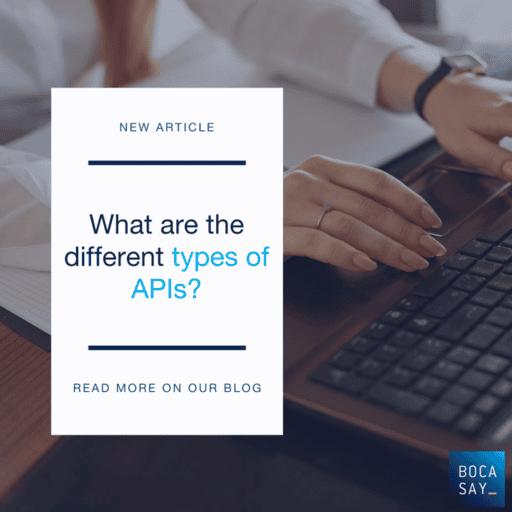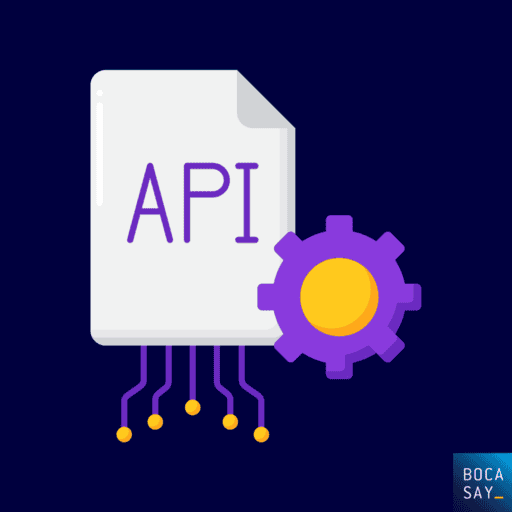What are the different types of APIs?
API stands for Application Programming Interface. They contain information that developers use in order to structure these requests and responses with a set of actions that developers can access.
In short, it is a mechanism that allows interaction between two applications using a set of rules.
There are several types of APIs, which can be classified in various ways. They have different uses, benefits and target audiences, each suited to different purposes.
APIs come in all shapes and sizes, giving developers the flexibility to choose the type of API that best suits their purpose. A common distinction is to group by audience. This gives us four categories: open APIs, partner APIs, internal APIs, and composite APIs.
While all APIs use software integration to increase data sharing and workflow, different types are designed to optimize specific operations, depending on business needs.
In this article, Bocasay, your Vietnam offshore development center, talks about different types of APIs.

Open APIs:
Open APIs represent an open-source format and initiative for the design and creation of machine-readable interface files, used to produce, describe, consume, and visualize APIs and web services. The open API allows software developers to define the essential elements of their API, including:
- The actual endpoints and operations of each endpoint.
- The parameters for input and output operations.
- Authentication techniques for items such as contact information, terms of use, licensing, etc.
The main advantage of using a standard definition is that third-party users can interact with and understand the service with minimal implementation logic, as long as they know the basics of RESTful APIs. API specifications are written in YAML or JSON, formats that are readable and easy to learn for machines and humans.
The open API specification comes from the Swagger project. The development company SmartBear decided to make the Swagger specification available under an open source license, entrusting its maintenance and development to the Open API Initiative.
In addition to SmartBear, the OpenAPI includes industry heavyweights such as Google, IBM and Microsoft as members. This project is also funded by the Linux Foundation.
Partner APIs:
Partner APIs are more limited in who can access the service, and they can be free or paid.
Partner APIs are among the most important and most used: eBays, Twitter or Airbnb APIs are examples.
To take the example of Twitter, its API is public and allows you to access a number of traditional Twitter access points once you have an API key. The more advanced level is called Elevated or Elevated+, which is only available to approved partners.
ℕ𝕖𝕖𝕕 𝕒 𝕕𝕖𝕕𝕚𝕔𝕒𝕥𝕖𝕕 𝕥𝕖𝕒𝕞 𝕠𝕗 𝕕𝕖𝕧𝕖𝕝𝕠𝕡𝕖𝕣𝕤 𝕥𝕠 𝕓𝕦𝕚𝕝𝕕 𝕪𝕠𝕦𝕣 𝔸ℙ𝕀? 𝕐𝕠𝕦𝕣 𝕍𝕚𝕖𝕥𝕟𝕒𝕞 𝕠𝕗𝕗𝕤𝕙𝕠𝕣𝕖 𝕕𝕖𝕧𝕖𝕝𝕠𝕡𝕞𝕖𝕟𝕥 𝕔𝕖𝕟𝕥𝕖𝕣 𝕚𝕤 𝕥𝕙𝕖𝕣𝕖! 𝕆𝕦𝕣 𝕥𝕒𝕝𝕖𝕟𝕥𝕖𝕕 𝕥𝕖𝕒𝕞𝕤 𝕒𝕣𝕖 𝕒𝕥 𝕪𝕠𝕦𝕣 𝕕𝕚𝕤𝕡𝕠𝕤𝕒𝕝 𝕥𝕠 𝕞𝕖𝕖𝕥 𝕒𝕝𝕝 𝕪𝕠𝕦𝕣 𝕕𝕚𝕘𝕚𝕥𝕒𝕝 𝕔𝕙𝕒𝕝𝕝𝕖𝕟𝕘𝕖𝕤 𝕚𝕟 𝕣𝕖𝕔𝕠𝕣𝕕 𝕥𝕚𝕞𝕖. 𝕐𝕠𝕦𝕣 𝕤𝕦𝕔𝕔𝕖𝕤𝕤 𝕚𝕤 𝕠𝕦𝕣 𝕔𝕠𝕣𝕖 𝕓𝕦𝕤𝕚𝕟𝕖𝕤𝕤.
Since partner APIs are only made available to certain parties, they tend to have stricter and more stringent rules for authorization, authentication and security.
So making an API available only to selected partners allows you to secure your API as much as possible. This is a good compromise between being fully private and fully public.
Internal APIs:
“Internal APIs” are those that companies use internally to:
- Add value.
- Increase productivity.
- Reduce time spent exchanging information between teams.
They are useful for the business side of the business, which could be considered the “back-end” of the company, without external customer involvement or monetization. They serve as tools to streamline your work.
In any business, teams need to communicate to get their work done and be productive. The problem lies in the security and speed of the transmission.
With the advent of the Internet, employees could make requests via email or find information stored on the company’s server. However, the “request -> receive” step was still necessary to get the information.
With this method, companies can streamline the sharing of data between departments and all locations within the company. Although access is limited to internal operations, internal APIs still include security measures to verify employee identity before allowing access to the system.
In addition, because internal APIs are typically not shared with third parties, developers don’t have to worry about extending security threats from internal APs to partner organizations or customers. They only need to manage the internal fallout.

Composite APIs:
Composite APIs are a design approach to grouping API requests in a sequential manner. This enhanced functionality makes it ideal for microservices, where multiple services are required to perform an operation. This allows a client to make a single API request and get a single response in a series of calls instead of making multiple trips to the server.
It also allows developers to access multiple endpoints, including web applications and/or other APIs, in a single procedure call. A composite API provides a more efficient design solution for the client. Instead of five or more requests, there is only one. Instead of parsing five or more responses, all necessary data is passed at the end of the sequence.
The robust infrastructure of the composite API improves the performance of data services and provides an all-in-one solution.